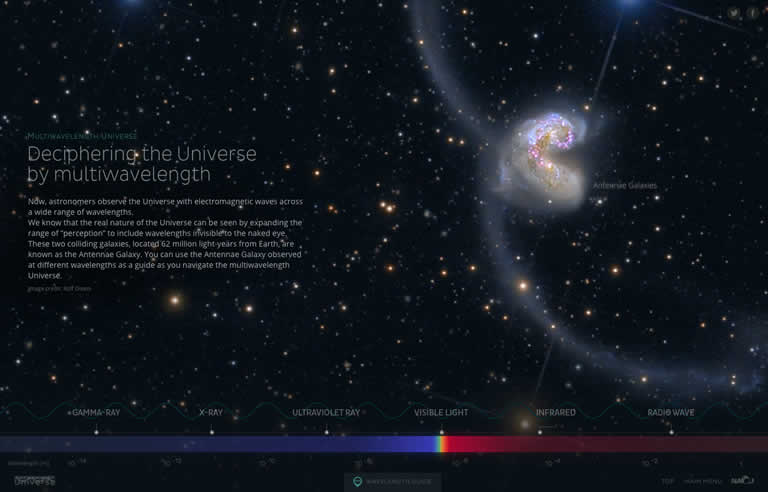Special Website “Multiwavelength Universe” English version has Opened.
| Topics

The National Astronomical Observatory of Japan (NAOJ) has created an English version of the special website “Multiwavelength Universe,” This website introduces various beautiful images of the Universe seen in multiwavelength by using the Antennae Galaxy observed at different wavelengths as a guide. By gathering beautiful and powerful astronomical images, we designed this site to be enjoyable, even if you only glance through it. Please feel free to enjoy it.
Motivation
We created the Japanese version of this website to answer questions, such as “What does it mean to observe in multiwavelength?”, “Why does NAOJ operate various telescopes?” The Japanese version has been available since May, 2015. This time, we created an English version of this website to deliver the contents to as many people as possible around the world. We hope that by using this website everyone will be able to understand the scientific meaning of ‘multiwavelength observations for clarifying the structure and formation of the Universe.’
Target Audience
This website is intended primarily for high school students and above. Some of the content would be appropriate for undergraduate education. We also hope it can be used as a resource for schools.
Website Content
This site introduces the appearance of celestial objects as seen in various wavelengths and what information the various wavelengths provide. Observational images of the Antennae Galaxy serve as the navigation guide.
The “Wavelength Guide” summarizes representative telescopes worldwide, the observational targets in each wavelength, and the bands of electromagnetic waves which reach ground level. In addition, we strive to introduce beautiful pictures taken by telescopes throughout the world. Please enjoy a multifaceted Universe beyond imagination.
A picture of the Universe taken using visible light which humans can see is just one aspect. By collecting various wavelengths of electromagnetic waves from the Universe, we can unravel the mysteries of the birth and development of the Universe, stars, and the formulation of planetary systems. We hope that you can appreciate the scientific meaning and importance of multiwavelength observation of the Universe, the beauty of the Universe, and the fascination of astronomy.
Editor’s Comment: Dr. Junichi Watanabe

Naked eye observations were the only method humans had to investigate the Universe until a little over 400 years ago. At the beginning of the 17th century, Galileo Galilei pointed a telescope toward the Universe and for the first time investigated the Universe which cannot be seen by the naked eye. In the 20th century, observations of the Universe were done not only through the (visible) light captured by unaided eyes, but also through radio waves, ultraviolet rays, infrared rays, X-rays and so on. Seen through these various electromagnetic waves, the Universe presents totally different images for the same celestial objects; each wavelength captures different kinds of information. Modern astronomers investigate the Universe by using these multiwavelength data.
We hope that through this website people will understand the excitement and importance of multiwavelength astronomy conducted at the frontier of modern astronomy.